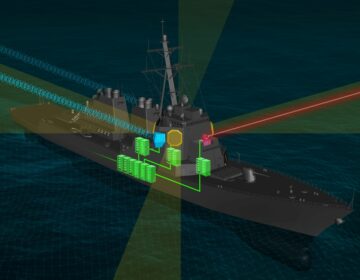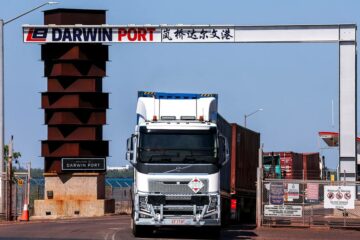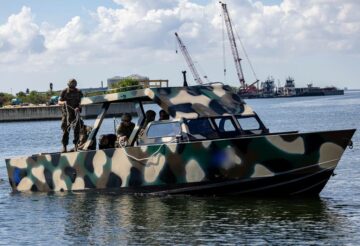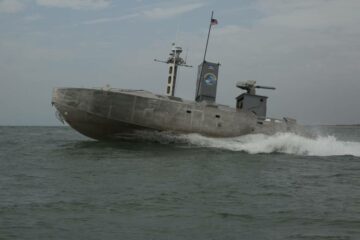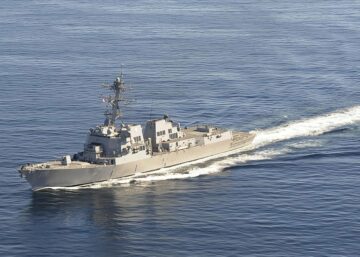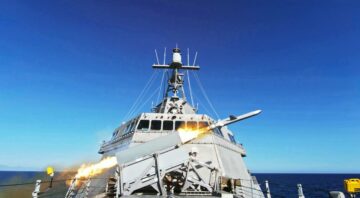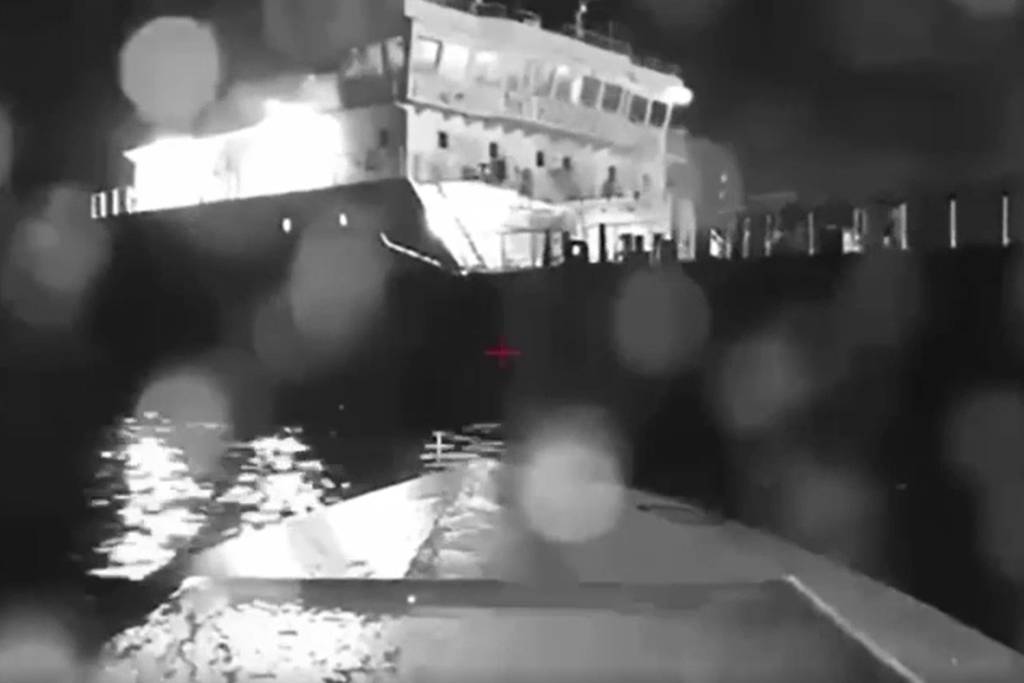
Ukraine has grabbed international attention with its asymmetric attacks using explosive-laden “sea drones” against Russian shipping and facilities in the Black Sea. They have no doubt embarrassed Moscow’s political and military leadership and added to a sense of Kyiv confounding the odds in the face of Russia’s aggression.
They have also been something of a wake-up call for many navies. The maritime domain has seemed for some time to be on the cusp of a new era embracing uncrewed surface and sub-surface platforms and systems, and these technologies look to be reaching a break-out point. These are among the factors behind the decision by the IISS to incorporate such capabilities into its military databases for the first time.
Ukraine has shown the way in quickly assembling some relatively modest technologies and fashioning them into an effective weapon system at moderate cost. Their overall success rate may be debated. They have had some luck in finding some poorly defended targets. The Houthi rebels in Yemen had already shown the way in using remotely operated explosive boats in the Red Sea, albeit not on the scale as the Ukrainians.
Ukraine’s use of these weapons against Russian ships in their bases has certainly alerted navies generally to refocus on some basic lessons of port security. In a way, these attacks have been the modern equivalent of the fire ships from the days of sail. But there are other lessons to be learned.
Several major navies have been grappling with how to deal with swarm attacks by fast boats, again with the Middle East experience in mind. Ukraine’s remote boats may add some further challenges, like very small radar and electro-optical signatures. Some of the counters to them may in the end be straightforward. They will include remote surface vessels themselves, equipped with appropriate monitoring and surveillance equipment and/or rapid-fire close-in weapons.
Such systems, both offensive and defensive, exist today and are increasingly in the portfolios of defense companies and on display at equipment exhibitions around the world. Interest in them will surely only increase.
But there is also a much broader transformation underway involving uncrewed, semi-autonomous and autonomous systems at sea. The problem has been that the transformation has been quite slow.
For some time, major fleets have been looking to uncrewed solutions to deliver effect in every scenario from the lethality of modern high-end warfighting to the requirement for persistent presence and domain awareness at the lower end of the maritime security scale.
It includes everything from basic surveillance and military data gathering to providing remote, distributed weapons platforms, on and below the sea surface. It could involve providing sustainable barrier defenses against submarines, because high-end crewed platforms are in too short supply and possibly transforming undersea warfare generally.
While Ukraine has been agile and rapid in coming up with a working solution, the process – not least in the case of the U.S. Navy – has seemed slow and painful. In part, that is down to the need to convince skeptics in places like the U.S. Congress. There are genuine design and doctrine challenges. The technology continues to evolve.
But a further contributory factor has seemingly been endless experimentation and indecision.
Among the first operational tasks identified for such systems was mine countermeasures (MCM). But navies are only now beginning to come to grips with the use of such systems. The Royal Navy has only just procured a “mother ship” from the commercial sector to test the deployability of an autonomous MCM capability.
The new theater of seabed warfare may also be an attractive application of the technology. The Nord Stream pipeline attacks were another wake-up call, underscoring the deficit in Western capabilities to monitor and protect critical undersea infrastructure.
The UK again is seeking to press an adapted commercial vessel rapidly into service as a first “multi-role ocean surveillance ship” hosting various sub-sea systems. But what exactly the critical capabilities should be, whether military or commercial, and to what extent this should be a naval mission, remain open questions.
Perhaps to make up for lost time, the U.S. Navy has been attempting to socialize the potential of various remote systems from experimental formations in real-world situations. The trailblazer has been Task Force 59 with Central Command in and around the Gulf and the Red Sea, using relatively small and simple platforms networked together to help improve maritime domain awareness and support maritime security operations.
However, experience so far suggests there is still some way to go in terms of reassuring allies and partners in the region. Deterring the opposition, in the shape of Iran, and proving that such systems can make up for fewer, more traditional crewed platforms also remains to be accomplished.
Clearly the right balance of trade-offs still needs to be struck between capability, affordability, and expendability, and how the different systems envisaged will need to be operated. Providing defensive capabilities to the platforms, even optionally crewing them in certain circumstances, may be answers, but they will add to cost and complexity. In some cases, in exposed operations even in grey zone scenarios, such systems will be lost.
U.S. Navy leaders insist these lessons are being learned. They need to be as a matter of urgency – not just in the United States – and some bets need to be placed to turn long-assumed potential into reality. In that sense, events in the Black Sea have sounded the alarm that both the opportunities and challenges of this technology are coming into focus now.
Nick Childs is a senior fellow specializing on naval forces and maritime security at the London-based International Institute for Strategic Studies.
- SEO Powered Content & PR Distribution. Get Amplified Today.
- PlatoData.Network Vertical Generative Ai. Empower Yourself. Access Here.
- PlatoAiStream. Web3 Intelligence. Knowledge Amplified. Access Here.
- PlatoESG. Automotive / EVs, Carbon, CleanTech, Energy, Environment, Solar, Waste Management. Access Here.
- PlatoHealth. Biotech and Clinical Trials Intelligence. Access Here.
- ChartPrime. Elevate your Trading Game with ChartPrime. Access Here.
- BlockOffsets. Modernizing Environmental Offset Ownership. Access Here.
- Source: https://www.defensenews.com/opinion/2023/09/11/ukraine-is-ushering-in-a-new-uncrewed-era-at-sea/
- :has
- :is
- :not
- $UP
- 70
- a
- accomplished
- adapted
- add
- added
- again
- against
- agile
- alarm
- already
- also
- among
- an
- and
- Another
- answers
- Application
- appropriate
- ARE
- around
- AS
- At
- Attacks
- attempting
- attention
- attractive
- autonomous
- autonomous systems
- awareness
- Balance
- barrier
- basic
- BE
- because
- been
- Beginning
- behind
- being
- below
- Bets
- between
- Black
- both
- broader
- but
- by
- call
- CAN
- capabilities
- capability
- case
- cases
- central
- certain
- certainly
- challenges
- circumstances
- CNN
- come
- coming
- commercial
- Companies
- complexity
- Congress
- continues
- convince
- Cost
- could
- counters
- critical
- Cusp
- data
- databases
- Days
- deal
- decision
- Defense
- defensive
- DEFICIT
- deliver
- Design
- different
- Display
- distributed
- domain
- doubt
- down
- East
- effect
- embracing
- end
- Endless
- equipment
- equipped
- Equivalent
- Era
- Even
- events
- Every
- everything
- evolve
- exactly
- Exhibitions
- exist
- experience
- experimental
- exposed
- extent
- Face
- facilities
- factor
- factors
- far
- FAST
- fellow
- fewer
- finding
- Fire
- First
- first time
- Focus
- For
- Force
- Forces
- from
- further
- gathering
- generally
- genuine
- Go
- had
- Have
- help
- High-End
- hosting
- How
- How To
- HTML
- HTTPS
- identified
- images
- improve
- in
- include
- includes
- incorporate
- Increase
- increasingly
- Infrastructure
- Institute
- interest
- International
- into
- involve
- involving
- Iran
- IT
- ITS
- jpg
- just
- leaders
- Leadership
- learned
- least
- Lessons
- like
- Look
- looking
- lost
- lower
- luck
- major
- make
- many
- Maritime
- Matter
- May..
- Middle
- Middle East
- Military
- mind
- Mission
- moderate
- Modern
- modest
- Monitor
- monitoring
- more
- much
- Need
- needs
- New
- no
- Nord Stream
- Nord Stream pipeline
- now
- ocean
- Odds
- of
- offensive
- on
- only
- open
- operated
- operational
- Operations
- opportunities
- opposition
- or
- Other
- overall
- painful
- part
- partners
- pipeline
- Places
- Platforms
- plato
- Plato Data Intelligence
- PlatoData
- Point
- political
- portfolios
- possibly
- potential
- presence
- press
- Problem
- process
- protect
- providing
- Questions
- quickly
- radar
- rapid
- rapidly
- Rate
- reaching
- real world
- Reality
- reassuring
- Red
- region
- relatively
- remain
- remains
- remote
- requirement
- right
- royal
- russian
- s
- Scale
- scenario
- scenarios
- SEA
- sector
- security
- Security Operations
- seeking
- seemed
- seemingly
- senior
- sense
- service
- Shape
- Shipping
- ships
- Short
- should
- shown
- Signatures
- Simple
- situations
- Skeptics
- slow
- small
- So
- so Far
- socialize
- solution
- Solutions
- some
- something
- sounded
- specializing
- States
- Still
- straightforward
- Strategic
- stream
- studies
- success
- such
- Suggests
- supply
- support
- surely
- Surface
- surveillance
- sustainable
- Swarm
- Systems
- targets
- Task
- task force
- tasks
- Technologies
- Technology
- terms
- test
- that
- The
- the world
- Theater
- their
- Them
- themselves
- There.
- These
- they
- this
- time
- to
- today
- together
- too
- traditional
- trailblazer
- Transformation
- transforming
- TURN
- u.s.
- u.s. congress
- U.S. Navy
- Uk
- Ukraine
- Ukraines
- Ukrainians
- Underway
- United
- United States
- urgency
- use
- ushering
- using
- various
- very
- Vessel
- vessels
- was
- Way..
- Weapons
- were
- Western
- What
- whether
- will
- with
- working
- world
- zephyrnet



